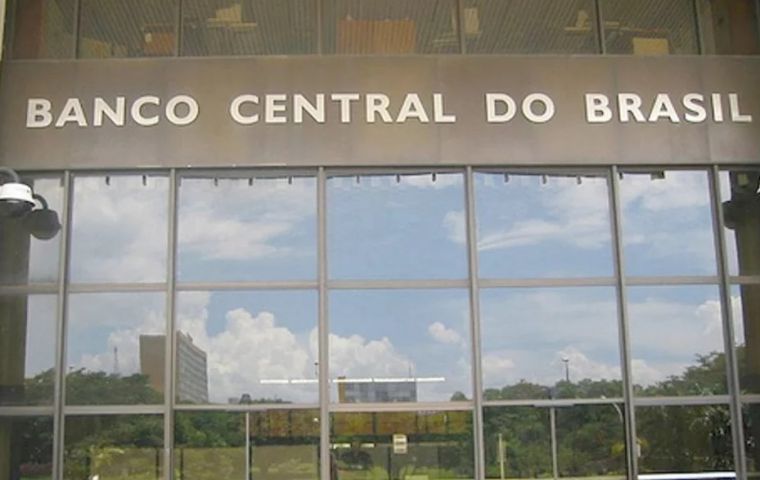MercoPress. South Atlantic News Agency
Brazil's Central Bank ups expansion forecast for 2024 to 2.09%
 The 2024 projection is within the inflation target range set by the BCB's National Monetary Council (CMN) of 3% (+- 1.5 percentage points)
The 2024 projection is within the inflation target range set by the BCB's National Monetary Council (CMN) of 3% (+- 1.5 percentage points) According to the latest issue of the Focus bulletin released Monday by Brazil's Central Bank (BCB), the economy in South America's largest country will grow by 2.09% this year, which represented an improvement from the previous 2.05% forecast, Agencia Brasil reported. The study also foresaw a yearly inflation of 3.76%.
For 2025, Brazil's Gross Domestic Product (GDP - the sum of goods and services produced in a country) is expected to grow by 2%. For 2026 and 2027, the financial market also projects a GDP expansion of 2% each year. In 2023, Brazil's economy grew by 2.9%, as per the Institute of Geography and Statistics (IBGE) data. In 2022, the growth rate was 3%.
The exchange rate between the local real (R$) and the American dollar (US$) is expected to stand at R$ 5 / US$ 1 by the end of 2024 and at R$ 5.05 the following year.
Focus also believed that the Broad National Consumer Price Index (IPCA) - considered the country's official inflation - in 2024 rose from 3.72% to 3.76%. For 2025, the inflation projection stood at 3.66%. For 2026 and 2027, the forecast is 3.5% each year.
The 2024 projection is within the inflation target range set by the BCB's National Monetary Council (CMN) of 3% (+- 1.5 percentage points).
Last month, driven mainly by food and healthcare, inflation stood at 0.38%, a sharp increase from 0.16% in March but lower than in April last year (0.61%). According to the IBGE, the IPCA has accumulated 3.69% yoy.
To achieve the inflation target, the Central Bank's main instrument is the basic interest rate, the Selic, set at 10.5% per year by the Monetary Policy Committee (Copom). The recent rise in the dollar and increased uncertainty have led the Central Bank to slow down the pace of interest rate cuts, which had been 0.5 percentage points, to 0.25 points.
From March 2021 to August 2022, Copom raised the Selic 12 times in a row, in a cycle of monetary tightening that began amid rising food, energy, and fuel prices. Between Aug. 2022 and Aug. 2023, the rate was kept at 13.75% per year, seven times in a row. Once prices were under control, the BCB started cutting the Selic rate.
Before the start of the upward cycle, the Selic had been reduced to 2% per year, the lowest level in the historical series that began in 1986.
Because of the economic contraction caused by the Covid-19 pandemic, the Central Bank lowered the rate to stimulate production and consumption. The rate remained at the lowest level in history from Aug. 2020 to March 2021.
According to financial market sources quoted by Agencia Brasil, the Selic rate should stand at 9.75% at the end of this year and fall to 9% in 2025 and 2026, to drop once again to 8.63% in 2027.
When the Monetary Policy Committee (Copom) raises the basic interest rate, it seeks to contain heated demand, which has an impact on prices because higher interest rates make credit more expensive and encourage savings. But in addition to the Selic rate, banks take other factors into account when setting the interest they charge consumers, such as the default risk, profit, and administrative expenses. Thus, higher rates can also hinder the expansion of the economy.
If the Copom lowers the Selic rate, credit becomes less expensive, thus encouraging production and consumption, reducing control over inflation, and stimulating economic activity.
(Source: Agencia Brasil)




Top Comments
Disclaimer & comment rulesCommenting for this story is now closed.
If you have a Facebook account, become a fan and comment on our Facebook Page!